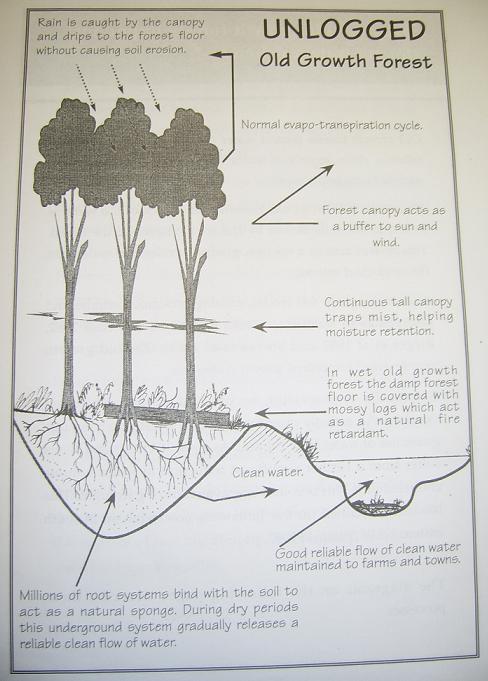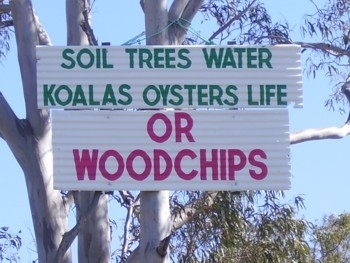Bushfire science
Mood:
 blue
Topic: wildfires
blue
Topic: wildfires

We noticed an abc Sydney radio report this morning on the Australian fire fighters union lobbying the Senate on climate change action. Here is a similar report from Feb 2009:
At risk' firies want urgent global warming action
By ABC News Online's Cassie White
Posted Thu Feb 12, 2009 3:46pm AEDT
Updated Thu Feb 12, 2009 4:48pm AEDT
Risk ... firefighters have been told to prepare for many more extreme fire danger days. (Getty: Scott Barbour)
Australia is at risk of more tragedies such as the Victorian bushfires if the Federal Government does not reassess its approach to global warming, says the peak firefighters union.
..................
A timely backgrounder also from our Ecology Action resources on an additional factor on how we got to this extreme wildfire scenario involving extreme dryness across NSW from local or global climate effects: There is a long run land use legacy of converting large areas of wet forest types into dry schlerophyll which burns fiercely. Refer this background paper:
These diagrams below first presented in 1995 reveal the process of landscape conversion of native forest from moist old growth fire resistant type, derived from their closed canopy, to dry sclerophyl bushfire prone regrowth type.
As long as a moisture rich closed canopy is in place a high density of ground cover remains of moderate risk and tends to break down quite quickly as well.
The most severe process of logging disruption of the closed forest canopy has been going on since the advent of high intensity 'integrated logging' for timber but also high proportion of woodchips especially since the mid 1970ies. This was around the time of the advent of bulldozers, other big machines and modern chainsaws.
Thus even if a small proportion of a forest of say 2 or 3% suffers high intensity logging per year, after 40 years of patchworking, close to 100% of the moist micro climate will have been destroyed along with the broken canopy. It will take maybe a century to re establish the moist old growth closed canopy microclimate across broad areas of forest IF devastating fires don't constantly set the clock back to zero again in a cruel ecological game of snakes and ladders.
That's how grim the situation has become in large areas of forested south east Australia as a result of rampaging logging and greed. Even much contemporary national park has been patchwork logged already prior to reservation in the last 40 years and still to regain closed canopy moisture. Depending on the fire patterns in the future they may never regain that closed canopy and moisture level.
There are many other factors contributing to bushfire such as ignition sources like arson or naturally occuring dry lightning. Climate impact of low rainfall also impacts fire intensity and risk. Ground fuel levels are also very significant.
But what is apparent in the current anxious reflections and research into how best to deal with the impending catastrophic fires of the futre is that the modern logging industry have been getting away with environmental murder that promotes mega bushfires. It all follows from breaching the natural water cycle under a closed canopy: 


The diagrams above are based on the following scientific papers:
Cornish PM (1982) The variation of dissolved ion concentration with discharge in some NSW streams, Forest Hydrologist, Forestry Commission of NSW, The First National Symposium on Forest Hydrology, eds. EM O'Loughlin & L J Bren, May 1982,
Rieger W A, Olive L J and Burgess J S (1982) Behaviour of sediment concentrations and solute concentrations in small forested catchments, University of NSW, Department of Geography, FAculty of Military Studies, The First National Symposium on Forest Hydrology, eds. E M O'Loughlin & L J Bren, May 1982
Stokes R A and Loh I C (1982) 'Sustaining Sensitive Wildlife Within Temperate Forest Landscapes: Regional Systems of Retained Habitat as a Planning Framework', pages 85-106 in Ecology and Sustainability of Southern Temperate Ecosystems, eds. Norton T W & Dovers S R, CSIRO 1994.
Wronski E (1993) Tantawangalo research catchments, Change in water yield after logging, Report to the Forestry Commission of NSW, 1st July 1993
Declaration: The editor/author was called as witness to the NSW Parliamentary Inquiry, and briefly to the Coronial Inquiry after the summer 1993-4 bushfires, as a representative of the Wilderness Society in NSW.
..............................................
More background
The public are noticing the intensity of forest fires seem to be greater and to have more devastating effects. Certainly there are many factors involved:
1.climate eg drought, very low humidity, hot winds etc.
2. ground fuel load is significant but notice
(a) closed canopy wet 'old growth' or rainforest is far more fire resistant than a dry sclerophyl eucalypt forest regardless of leaf litter, and dry sclerophyl is being spread like a curse by the woodchipping sector. The wet fire resistant nature of old closed canopy is not our invention: An excellent scientifically referenced booklet called 'Old Growth Forests and their High Conservation Values' was published in Feb 1995 by Taylor, Woof, Thomson with relevant diagrams. We submit this process has contributed disastrously to fire intensity over the last 35 years and could literally take centuries to reverse, short of concreting the lot. No one wants that.
(b) that the high ground vegetation grazing pressure by ground dwelling native herbivores has been greatly reduced as a result of feral predators killing these critters off.
3. arson: A recent Institute of Criminology report late 2004 found up to 9 out of 10 fires are started by arsonists and in NSW the government have taken action to address this. This was the concern of green groups from at least 1993 but largely ignored by authorities until now.
4. escaped logging fires. These are less arson, as negligent land practices. Evidence of these are listed further below.
In the area of fire management the politics of the Carr NSW government are on track compared with so many other land use policy areas ...if one ignores the underlying landscape transforming impact of woodchipping Carr has so far failled to ban: We submit that closed canopy forests have been systematically wiped out in Australia especially in the last 40 years, which has destroyed the natural water cycle and humidity in forest understorey and more generally.
In the environment movement we still hear, not so much in NSW, but from colleagues in Victoria and elsewhere cheap shots at greenies not pulling their weight in rural fire brigades etc. When we last investigated this point in 1994 during during the Black Friday bushfire crisis we learned that 20 or 30 places across regional NSW had greenies in their local brigade ... that rural people invariably pull together whatever their politics.
One fellow in the north east angrily commented he was the driver of the local fire truck and it was in his driveway. The letter I wrote rebutting such nasty cheap political shots was printed in virtually every local newspaper in NSW including letter of the week in The Land newspaper. People were in no mood for cheap smears during such a serious bushfire event. We have no reason to doubt that reality in 2005 and beyond.
Source documents can be found in the following links:
13 Dec 2006 ...Howard’s divisive politics: bushfire green baiting today, dog whistle white supremacism yesterday
April/May 2003...El Grande, Tasmania: fire vandalism by govt logger/regulator exposed by expert botanist
Posted by editor
at 8:35 AM EADT
Updated: Thursday, 19 November 2009 10:06 AM EADT



